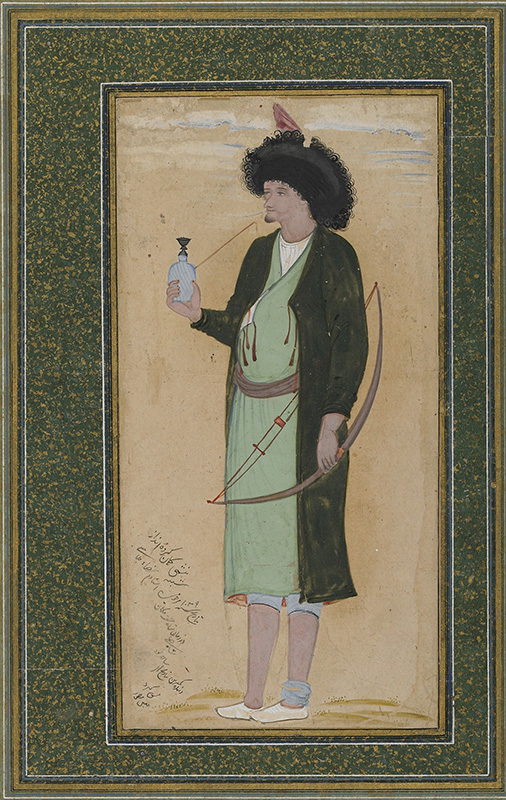Moʿin Moṣavver | Individual Drawings and Paintings
Drawing 1670.2
Našmi the Archer
Location: Arthur M. Sackler Gallery, Smithsonian Institution, Washington D.C. S1998.15. Bequest of Adrienne Minassian. Formerly in the Collection of Kikor Minassian.
Painting: (H x W) page 30.7 x 0.6 cm.
Signature: Unsigned and undated. Circa 1670. Later attribution to Moʿin Moṣavver
Inscription
Lower left, in what could be Moʿin's handwriting:
našmi kamān gard za andāz šamba betāreḵ-e sana 1039 marḥum-e ostādam reżā-ye ʿābbāsi dar zamān-e šāh ṣafi setahat-e makān-e sāḵta bud ...[balance of original inscription effaced and illegible]...
Below the first inscription, is an additional inscription, slightly darker and in a less accomplished hand, perhaps of later date: va banda kamtarin betāreḵ-e haft-e ...[illegible]...mašq kard moʿin-e moṣavver.
Translation: "Našmi the Archer. One day in the year 1039/1629 my late master Reżā ʿĀbbasi created [this composition] for and in the house of Shah Ṣafi. [Subsequently] this most humble person on the seventh of ...[effaced]... copied it. Moʿin Moṣavver."
Description:
Našmi the Archer is portrayed as a rather discheveled man, quite possibly intended as a caricature. He stands facing the left, with a waterpipe in one hand, while clutching his bow neatly tucked under his left arm. His face is taut, his belly pouched, his robe open,white slippers and apparently wearing only one sock - clearly not the image of a valiant warrior.
Bibliography:
Unpublished
Commentary:
Initially, this painting appears to be a solid attribution to Moʿin Moṣavver: the lengthy inscription quite possibly, at least in part, in Moʿin's hand, deft draftsmanship, near garrish color scheme, and a good sense of wit. But we have no comparable known Moʿin works that might lead us to say unquestionably by him. So, the accuracy of the inscription becomes more important than otherwise in determining the validity of the attribution. If the top inscription is indeed by Moʿin, he states that Reżā painted this subject in 1039/1629. And the second inscription, perhaps an attribution of later date, states that Moʿin, made this copy sometime after. Another portrayal of Našmi in the Harvard Art Museums, Fogg Museum (1960.197) is identical to this one except for minor details - the face and the waterpipe are slightly different, and the color scheme more subdued. The inscription has been effaced, but still quite legible. It is clearly in Reżā's hand, signed and dated by the master, The date recorded is 3 šanba čahār-e rabiʿ al-aḵer sana 1039/ Wednesday 4 November 1629, not Saturday 4 Rabiʿ al-aḵer 1031/16 Feb 1622 as Welch (SA_1973, p.65, no.12) states. 1039/1629 is important; it is precisely the year Moʿin cites as when Reżā's original version was painted. The evidence strongly suggests a sound attribution of both paintings, to Reżā and Moʿin respectively. However, the question remaining unanswered is, why did someone go the trouble of erasing parts of the incriptions on both paintings?
Photo copyright © Freer Gallery of Art and Arthur M. Sackler Gallery, Smithsonian Institution, Washington D.C..
Robert Eng
Last Updated: December 30, 2018 | Originally published: December 30, 2018
Drawing 1670.2
Našmi the Archer
Location: Arthur M. Sackler Gallery, Smithsonian Institution, Washington D.C. S1998.15. Bequest of Adrienne Minassian. Formerly in the Collection of Kikor Minassian.
Painting: (H x W) page 30.7 x 0.6 cm.
Signature: Unsigned and undated. Circa 1670. Later attribution to Moʿin Moṣavver
Inscription
Lower left, in what could be Moʿin's handwriting:
našmi kamān gard za andāz šamba betāreḵ-e sana 1039 marḥum-e ostādam reżā-ye ʿābbāsi dar zamān-e šāh ṣafi setahat-e makān-e sāḵta bud ...[balance of original inscription effaced and illegible]...
Below the first inscription, is an additional inscription, slightly darker and in a less accomplished hand, perhaps of later date: va banda kamtarin betāreḵ-e haft-e ...[illegible]...mašq kard moʿin-e moṣavver.
Translation: "Našmi the Archer. One day in the year 1039/1629 my late master Reżā ʿĀbbasi created [this composition] for and in the house of Shah Ṣafi. [Subsequently] this most humble person on the seventh of ...[effaced]... copied it. Moʿin Moṣavver."
Description:
Našmi the Archer is portrayed as a rather discheveled man, quite possibly intended as a caricature. He stands facing the left, with a waterpipe in one hand, while clutching his bow neatly tucked under his left arm. His face is taut, his belly pouched, his robe open,white slippers and apparently wearing only one sock - clearly not the image of a valiant warrior.
Bibliography:
Unpublished
Commentary:
Initially, this painting appears to be a solid attribution to Moʿin Moṣavver: the lengthy inscription quite possibly, at least in part, in Moʿin's hand, deft draftsmanship, near garrish color scheme, and a good sense of wit. But we have no comparable known Moʿin works that might lead us to say unquestionably by him. So, the accuracy of the inscription becomes more important than otherwise in determining the validity of the attribution. If the top inscription is indeed by Moʿin, he states that Reżā painted this subject in 1039/1629. And the second inscription, perhaps an attribution of later date, states that Moʿin, made this copy sometime after. Another portrayal of Našmi in the Harvard Art Museums, Fogg Museum (1960.197) is identical to this one except for minor details - the face and the waterpipe are slightly different, and the color scheme more subdued. The inscription has been effaced, but still quite legible. It is clearly in Reżā's hand, signed and dated by the master, The date recorded is 3 šanba čahār-e rabiʿ al-aḵer sana 1039/ Wednesday 4 November 1629, not Saturday 4 Rabiʿ al-aḵer 1031/16 Feb 1622 as Welch (SA_1973, p.65, no.12) states. 1039/1629 is important; it is precisely the year Moʿin cites as when Reżā's original version was painted. The evidence strongly suggests a sound attribution of both paintings, to Reżā and Moʿin respectively. However, the question remaining unanswered is, why did someone go the trouble of erasing parts of the incriptions on both paintings?
Photo copyright © Freer Gallery of Art and Arthur M. Sackler Gallery, Smithsonian Institution, Washington D.C..
Robert Eng
Last Updated: December 30, 2018 | Originally published: December 30, 2018
